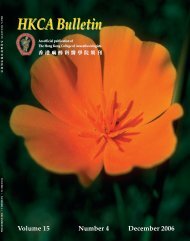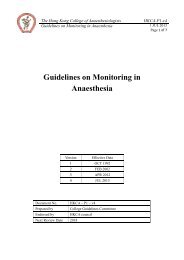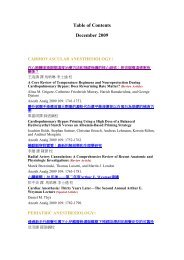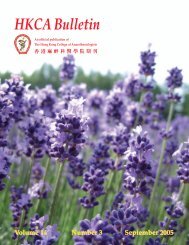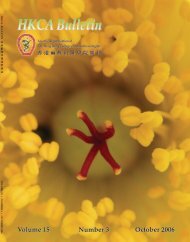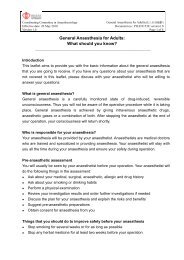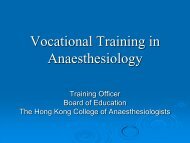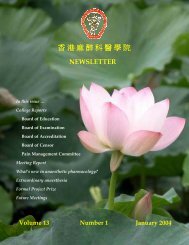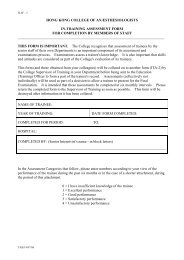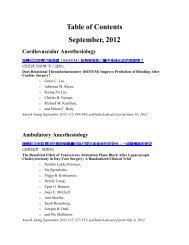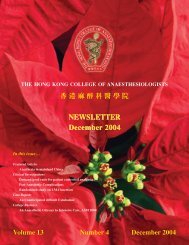July 2005 - The Hong Kong College of Anaesthesiologists
July 2005 - The Hong Kong College of Anaesthesiologists
July 2005 - The Hong Kong College of Anaesthesiologists
You also want an ePaper? Increase the reach of your titles
YUMPU automatically turns print PDFs into web optimized ePapers that Google loves.
Bull HK Coll Anaesthesiol Volume 14, Number 2 <strong>July</strong> <strong>2005</strong>abscess. Communications between the acutepain service, ward clinicians and nurses arecritical.<strong>The</strong> definitive diagnosis relies on imagingstudies. MRI scan <strong>of</strong> the spine with or withoutgalolinium enhancement is now the goldstandard. 18,19 Both the extent and location <strong>of</strong> theabscess can be clearly defined. MRI scan issuperior to computerized tomographic (CT)myelography as the former allows directmultiplanar imaging and visualization <strong>of</strong> s<strong>of</strong>ttissue including the spinal cord and theparaspinal musculature. However, not allhospitals in <strong>Hong</strong> <strong>Kong</strong> has a 24‐hour MRIservice and very <strong>of</strong>ten, as in this case, the patienthas to be transferred to another hospital forimaging. This <strong>of</strong>ten creates further delay indiagnosis and treatment.Once the diagnosis <strong>of</strong> an epidural abscess ismade, an expedited management strategy mustbe initiated. <strong>The</strong> mainstay <strong>of</strong> treatment involvesemergency multilevel decompressivelaminectomy, evacuation <strong>of</strong> pus and parenteralantibiotics. Empirical broad spectrum antibioticswith bactericidal activity against Staphylococcusaureus and gram negative organisms must bechosen. <strong>The</strong>y should be continued for no lessthan four weeks regardless <strong>of</strong> the requirement <strong>of</strong>surgery followed by oral therapy for at least twomore months. 6,20 <strong>The</strong> duration <strong>of</strong> antibiotictherapy is determined by the clinical response,biochemical markers and radiological resolution<strong>of</strong> the lesion. Further treatment is required whenthere is concomitant osteomyelitis, persistentlyelevated inflammatory markers and bacteremia. 6In some cases, patients can be treatedconservatively without surgical decompression.21,22 <strong>The</strong> nonsurgical approach can beconsidered for patients with severe medicalcomorbidities, absence or minimal neurologicalsymptoms, extensive abscess precluding surgeryand paraplegia <strong>of</strong> more than 72 hours when thechance <strong>of</strong> neurological improvement aftersurgery is minimal. 7,23 If the conservativeapproach is chosen, serial MRI scans withregular and frequent neurological examinationsare essential. Further surgical intervention canthen be initiated if necessary. High dose98intravenous steroid therapy is relativelycontraindicated as it may exacerbate theongoing infection and sepsis. 24<strong>The</strong> neurological outcome is closely related tothe time between the development <strong>of</strong> symptomto surgical decompression. In a studyinvestigating long term outcome afterneurosurgery for epidural abscess followingcatheter insertion, only 31% <strong>of</strong> the patientsreferred to neurosurgery improved aftersurgery. 1 Only 20% with paraplegia made acomplete recovery without deficits at hospitaldischarge. Long term follow up revealed that55% <strong>of</strong> patients with paraplegia had experiencedsome improvement in motor function at somestage but 44% still suffered from bladder and, orbowel dysfunction. 1 Our patient had someimprovement in motor function after dischargebut still suffered from bladder dysfunction sixmonths after her initial surgery.Infection control measures aiming atminimizing the risks <strong>of</strong> infection followingepidural catheter insertion have beenrecommended. 25,26 <strong>The</strong> guidelines include:(1) strict aseptic technique;(2) closed delivery system;(3) use <strong>of</strong> a 0.22 μm bacterial filter within thesystem;(4) inspection <strong>of</strong> the epidural punctured siteevery eight hours;(5) change <strong>of</strong> filter, infusion line and infusate at96 hours or discontinue use and(6) preparation <strong>of</strong> the infusate under sterileconditions in the pharmacy. 26In our case, the infusate was prepared in 500ml bag by the anesthesiologist in a clean but notsterile condition and the catheter site wasinspected only once a day by our acute painservice team.Furthermore, more isolates from cultureswere obtained following skin disinfected with 10% povidine iodine than in those disinfected with0.5% chlorohexidine in 80% ethanol. 27 It has alsobeen recommended that the disinfectant shouldbe left in contact with skin for at least oneminute before skin puncture. Our hospital hasnow replaced all povidine solution by 0.5%chlorohexidine in 80% alcohol as disinfectant in




